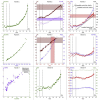Cardiopulmonary Exercise Testing in Heart Failure
- PMID: 38535093
- PMCID: PMC10970724
- DOI: 10.3390/jcdd11030070
Cardiopulmonary Exercise Testing in Heart Failure
Abstract
Cardiopulmonary exercise testing (CPET) provides important information for the assessment and management of patients with heart failure. This testing measures the respiratory and cardiac responses to exercise and allows measurement of the oxygen uptake (V˙O2) max and the relationship between minute ventilation (V˙E) and carbon dioxide excretion (V˙CO2). These two parameters help classify patients into categories that help predict prognosis, and patients with a V˙O2 < 14 mL/kg/min and V˙E/V˙CO2 slope >35 have a poor prognosis. This testing has been used in drug trials to determine complex physiologic responses to medications, such as angiotensin-converting enzyme inhibitors. For example, a study with enalapril demonstrated that the peak V˙O2 was 14.6 ± 1.6 mL/kg/min on placebo and 15.8 ± 2.0 mL/kg/min on enalapril after 15 days of treatment. The V˙E/V˙CO2 slopes were 43 ± 8 on placebo and 39 ± 7 on enalapril. Chronic heart failure and reduced physical activity measured by cardiopulmonary exercise testing are associated with increases in BNP, and several studies have demonstrated that cardiac rehabilitation is associated with reductions in BNP and increases in V˙O2. Therefore, BNP measurements can help determine the benefits of cardiac rehabilitation and provide indirect estimates of changes in V˙O2. In addition, measurement of microRNAs can determine the status of skeletal muscle used during physical activity and the changes associated with rehabilitation. However, CPET requires complicated technology, and simpler methods to measure physical activity could help clinicians to manage their patients. Recent advances in technology have led to the development of portable cardiopulmonary exercise testing equipment, which can be used in various routine physical activities, such as walking upstairs, sweeping the floor, and making the bed, to provide patients and clinicians a better understanding of the patient's current symptoms. Finally, current smart watches can provide important information about the cardiorespiratory system, identify unexpected clinical problems, and help monitor the response to treatment. The organized use of these devices could contribute to the management of certain aspects of these patients' care, such as monitoring the treatment of atrial fibrillation. This review article provides a comprehensive overview of the current use of CPET in heart failure patients and discusses exercise principles, methods, clinical applications, and prognostic implications.
Keywords: cardiopulmonary exercise testing; heart failure; prognosis; treatment.
Conflict of interest statement
The authors declare no conflict of interest.
Figures
References
-
- Mapelli M., Salvioni E., Mattavelli I., Vignati C., Galotta A., Magrì D., Apostolo A., Sciomer S., Campodonico J., Agostoni P. Cardiopulmonary exercise testing and heart failure: A tale born from oxygen uptake. Eur. Heart J. Suppl. 2023;25((Suppl. C)):C319–C325. doi: 10.1093/eurheartjsupp/suad057. - DOI - PMC - PubMed
-
- Watanabe T., Tohyama T., Ikeda M., Fujino T., Hashimoto T., Matsushima S., Kishimoto J., Todaka K., Kinugawa S., Tsutsui H., et al. Development of Deep-Learning Models for Real-Time Anaerobic Threshold and Peak O2 Prediction during Cardiopulmonary Exercise Testing. Eur. J. Prev. Cardiol. 2023 doi: 10.1093/eurjpc/zwad375. - DOI - PubMed
-
- De Souza I.M.A., Da Silveira A.D., Stein R., Ramos J.S.P., Ribeiro R.S., Pazelli A.M., De Oliveira Q.B., Darze E.S., Ritt L.F. Independent and additional value of cardiopulmonary exercise test to the New York Heart Association classification in heart failure. J. Am. Coll. Cardiol. 2022;79:1440. doi: 10.1016/S0735-1097(22)02431-7. - DOI
Publication types
LinkOut - more resources
Full Text Sources



